
Drowning and Resuscitation Pages: 1 2 3 4 5 6 7 Next>>
Resuscitation of Drowning Victims at Sea, Page 4
Resuscitation Techniques Used by the Amsterdam Society 1767-1771
We now consider a facet of resuscitation which took place more than 40 years past the golden age of piracy. The reason is that this body of work shed a great deal of insight into resuscitation techniques near the golden age of piracy. One book in particular (and the two English translations which followed it) contains a large number of case studies. We have an opportunity to do some simple statistical analysis. (Very simple.) However, even though the majority of the resuscitation techniques in this book were the same as those found in period works, this information cannot be said to be wholly relevant to the period. As such, those of you wishing to adhere more closely to what was known about resuscitation during the golden age may wish to skip to the next page.
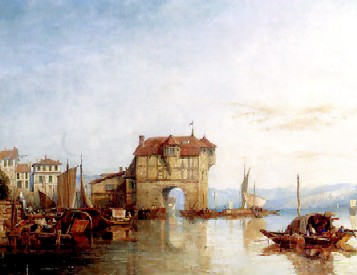
Artist: James Baker Pine, Zurich (19th c.) The resuscitation of drowning victims began to attract the public interest in the 1760s, continuing to increase and expand for the next 40 years. In 1766, a governmental edict in Zurich explained,
Experience has shown that the drowned who are considered dead and that lay for some time under water have often been restored again and kept alive by proper maneuvers. From which one rightly concludes that life has not been completely suspended in the drowned, but that there is hope to save them from death if, as soon as they are withdrawn from the water, prompt and careful help is administered.1
The next year, a "society to restore drowned persons was formed by a group of wealthy merchants of Amsterdam in an attempt to aid in the resuscitation of the many drowned in their waterways."2 These Dutch benefactors had to work against beliefs in place in their society since many Amsterdam residents believed "that when a drowned person is taken out of the water, without any signs of life, no one is permitted to take him into his house,
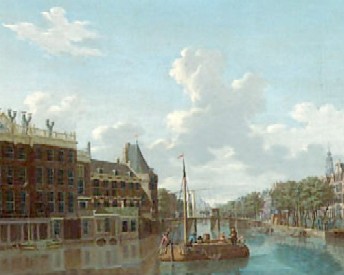
Artist: Isaak Ouwater
View of the Kloveniersburgwal in Amsterdam (1770s)
or even to touch him, excepting it be to suspend him by the side of the canal, with his head above water; and that when any one is suspending in this manner, none but the governors of the hospital may loosen him"3.
Due largely to this concern, the society published an advertisement offering medals and monetary rewards to anyone "that by the use of the proper methods... has recovered a grown person or child, that has been taken out of the water without any signs of life"4. The advertisement assured the reader that "such assistance is no infringement upon the laws; for these laws, proposing the public good for their object, not only permit such unfortunate persons to be taken out of the water, but every suitable method to be tried, in order to restore them to life"5.
There followed an extensive list of procedures to be employed by the citizens of Amsterdam which could be used to restore the nearly drowned. The general outlines of these methods should look familiar. The society had added several interesting details which may help us to understand how the broader purpose could be achieved. (I have inserted some paragraph breaks into the text for clarity, otherwise it has been left as found in Cogan's book.)
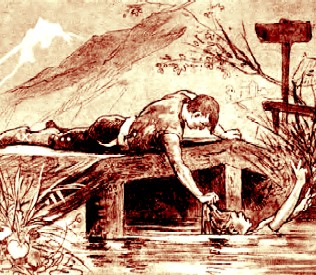
Artist: Carl Larsson, from the book Folksagor (1927 )
1. To blow into the intestines through a tobacco-pipe, or the sheath of a knife, cutting off the lower point. The sooner this operation is performed with force and assiduity, the more useful it will prove. If a lighted pipe of tobacco, or fumigator constructed for that purpose, be made use of, the operation will be more effectual; for thus, instead of simple air or wind, the warm irritating fumes of tobacco are introduced into the intestines. In whatsoever manner this be done, it is in general the first thing that can be tried, and can be executed without loss of time, either in a boat or on land, in short, wherever the drowned person was immediately placed.
2. It will be necessary as soon as possible to dry and warm the body with care, which will often be quite sodden, sometimes absolutely cold, benumned, and even stiff. This can generally be done with ease, and that several ways: for example, by a warm shirt, and the under clothes of one of the assistants; by one or more woolen blankets previously warmed, by hot embers from a brewery, bakehouse, saltern, soap-boilers, or other fabrics; by the skins of animals, especially of sheep; by a moderate fire, or by the gentle and natural warmth of healthy persons placing themselves in bed with the drowned.
Whilst the two preceding methods are employed with circumspection and assiduity, it may be very serviceable to make use of strong frictions [rubbing] all over the body, particularly down the spine or back from the neck to the rump, with flannels, or cloths, steeped in brandy; or sprinkled with fine dry salt, or with linen wetted with brandy, or some strong volatile salt, as the spirits of ammoniacal salts, should also be applied to the nostrils or rubbed upon the temples.
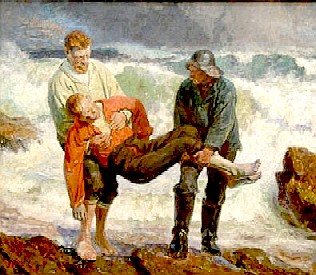
Artist: Laurits Tuxen, The Drowned is Brought to Shore (1913)
Tickling of the nostrils and throat may also prove beneficial; but not any wine, or brandy, or any strong liquor, mixed with salts or other stimulants, should be poured down the throat until some signs of life are perceived.
The following experiment has proved successful: let one of the assistants, applying his mouth to that of the drowned, closing the nostrils with one hand, and pressing the left breast with the other, blow with force, and endeavour to inflate the lungs. We believe, that, from the beginning, this might be as efficacious as blowing up the fundament. [Dr. Cogan comments in a footnote to this point: I have great reason to believe that blowing with force into the lungs is the most efficacious method. I have frequently observed in children still born, the heart and carotid arteries to beat strong, when it was applied; but that all pulsation had ceased upon discontinuing this in order to try other experiments, which has returned upon repeating the operation. I have frequently been detained upwards of an hour by this alternate life and death, sometimes with, and sometimes without a happy issue.]
In a word, to draw blood, if it be possible, or as soon as it is possible, from a larger vein in the arm, or the jugular itself, should by no means be neglected.6
Over a thousand copies of this advertisement were "affixed in different parts of Amsterdam, and public charities, coffee houses, taverns &c. to the smallest ale-houses, and also to surgeons and physicians."7 In his English interpretation of the original Dutch publication of the results - Historie en Gedenkschriften van de Maatschappy, tot Redding van Drenkelingen, Opgerecht Binnen Amsterdam - It was reported that, "By virtue of it [the society's advertisement and rewards] upwards of a hundred and fifty persons, may, with strictest propriety, be said to have been raised from the dead: for without its timely interposition, they must have infallibly perished."8
English Publication of the Historie
Two English authors found this information interesting enough to translate it from the original Dutch and
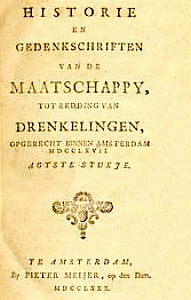
The Title Page of Historie en
Gedenkschriften van de
Maatschappy,
tot Redding van
Drenkelingen,
Opgerecht Binnen
Amsterdam (1780)
publish it in English. The first was Dr. Alexander Johnson, who released the work as A Short Account of a Society at Amsterdam Instituted in the Year 1767 For the Recovery of Drowned Persons, London, England in 1773. Johnson's version is simple and easy-to-read, but he seems to have removed a great many of the cases. He explains, "Many of them [the cases] appear to have been drawn up by illiterate persons; therefore such idle circumstances as are nothing to the purpose are left out of this Translation."9
The second author to translate the work was Dr. Thomas Cogan whose book Memoirs of the Society Instituted at Amsterdam in Favour of Drowned Persons for the Years 1767, 1768, 1770 and 1771 appeared in 1774. Cogan explains that his book was ready for press, but not yet printed when Johnson's work appeared. He notes, "I find upon comparing them, that they do not interfere with each other so much as to induce me to suppress the publication of mine."10
Cogan's work is clearly closer to the original, which was published in four parts, something Johnson's book doesn't do. Cogan's version also includes far more case studies. Even some of the cases printed in both books contain varying information. Still, Cogan admitted while the first two parts were "translated fully... some other parts I have taken the liberty to abride very considerably... though care is taken to omit nothing which seemed of the moment"11.
As a result, although Cogan's book is more complete than Johnson's, it is still not all encompassing. Cogan notes that "these Memoirs were written at different periods, [so] repetitions were in some places proper, in others unavoidable... yet those repetitions or minute circumstances are erased, which would have increased the size of the book, and only have been tedious to the English reader."12
A Good Idea Takes Flight
The Dutch society and its publications were to set off a wave of interest in reviving the nearly drowned. By the end of 1768, fifteen cities and several 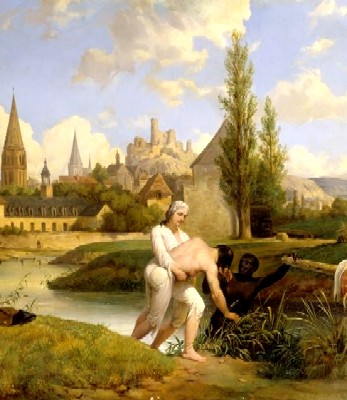
Artist: Emile Vernet-Lecomte
The Duke of Chartres Saves Drowning Engineer Siret in August 1791
states of the Dutch Republic had issued mandates in favor of assisting the drowned.13 After this, resuscitative societies began to gain interest in other nations. In the introduction to his version of the Historie, Johnson breathlessly reported, "The Boards of Health at Venice, Milan and Padua, have adopted it – The City of Hamburgh has done the same – The Empress of Russia has countenanced it in her dominions – The Empress Queen of Hungary has given very particular encouragement to it – And in France it is at this time under consideration, by what means it may best be united with the general police of the kingdom."14
Both Johnson and Cogan had recommended the creation of such a society in Great Britain.15 After reading Cogan's book, Dr William Hawes met with Cogan to co-found The Society for the Recovery of Persons Apparently Drowned on April 18, 1774.16 Cogan and Hawes "invited sixteen friends to join them in founding an institution. Those present at this meeting included physicians, surgeons and other prominent men."17
The purposes of the society was the same as the that of the Dutch society - to encourage people to resuscitate those who had stopped breathing through medals and rewards and to research and publish information that would advance progress in the field of resuscitation. The name of the Society was eventually changed to the much less onerous Humane Society which eventually became The Royal Humane Society. This is what it is called today. The Society's website reports some fascinating statistics.
By 1777, the Society had recorded 167 cases, and by 1794, 2572 cases had been investigated, of which 959 persons had been restored to life by the medical assistants, 876 lives had been preserved by the Society's apparatus, and 747 cases had been unsuccessful. By 1809, more than 15,000 cases had been reported and eight receiving houses were in operation.18
So the humble little Dutch society for resuscitating people became an international phenomenon.
Resuscitation Case Study Statistics
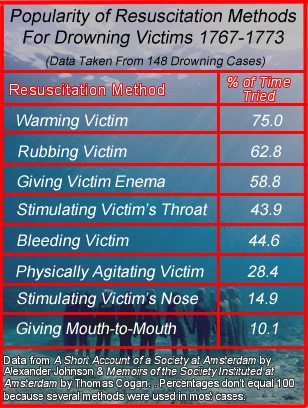
Resuscitation Methods by % 1767-1773
Background Image by Jason Descaires Taylor, "Vicissitudes"
The bulk of the Historie consists of a series of cases which were reported to the Dutch society. Some of the cases are quite vague as to what treatments were used to resuscitate (or attempt to resuscitate) drowning victims and others are extraordinarily specific.
It seemed an interesting collection of data, so I decided to take it and come up with a table of methods tried as a percentage of the total number of usefully descriptive cases. Perhaps the most curious thing about the chart is that the least-tried method is today recommended as being the most (if not the only) one for successful resuscitation of an unconscious drowning victim.
I used the data found in both the books of Drs. Cogan and Johnson. Between the two books, I found 148 cases that mentioned specific resuscitation methods, the majority of which came from the Dutch cases. Any case that did not indicate the specific resuscitation method used was excluded from this data. Only drowning cases were used. Where there were overlapping case studies in the books which reported different resuscitation techniques, I included both techniques in my data. Note that not all cases included here were successful in resuscitating the victim; this is only a study of how often each method was tried as a percentage of the total number of cases used.
As indicated above, each resuscitation method contains more precise subcategories. For example, "Giving Victim Enema" includes air enemas, smoke enemas and the typical liquid enemas. Some methods, such as Stimulating Victim's Throat, contain many different sub categories. These will be discussed on the following page when each method is examined in greater detail.
1 Steven B. Harris, "The Society for the Recovery of Persons Apparently Dead", Cryonics, September 1990, alcor.org, gathered 12/2/13; 2 K. Garth Huston, Resuscitation: An Historical Perspective, p. 9 3,4 Thomas Cogan, Memoirs of the Society Instituted at Amsterdam in Favour of Drowned Persons for the Years 1767, 1768, 1770 and 1771, p. 2; 5 Cogan, p. 3; 6 Cogan, p. 3-4; 7 Cogan, p. 5; 8 Cogan, p. 8; 9 Alexander Johnson, A Short Account of a Society at Amsterdam Instituted in the Year 1767 For the Recovery of Drowned Persons, p. 6; 10 Cogan, Advertisement, first page; 11,12 Cogan, p. iii; 13 Cogan, p. 13-4; 14 Johnson, p. 6-7; See 14 Johnson, p. 9-10 & Cogan, p. v-vii; 16 Huston, p. 14 & "Royal Humane Society", The Royal Humane Society Website, gathered 12/2/13; 17, 18 "Administrative/Biographical history", Royal Humane Society Website, gathered 12/2/13

